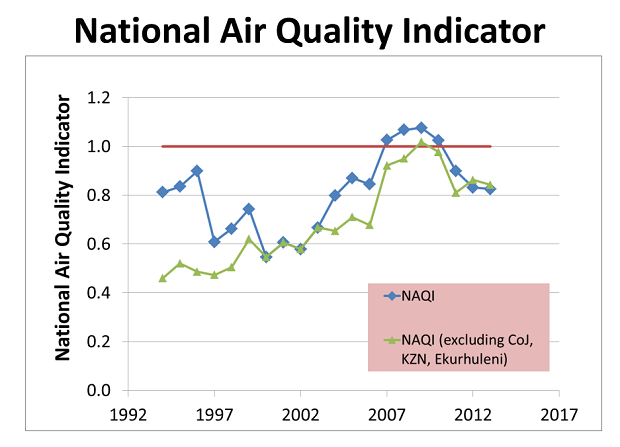Although South Africa is reportedly one of the highest CO2 emitters in the world, the quality of the air we breathe has gotten a bit better on a national scale, according to the 2014 State of the Air Report which was released at the 9th Annual Air Quality Governance Lekgotla in Durban yesterday.
The State of the Air Report covers air quality data from 2005 to 2013 focusing on major metropolitans, provinces (KwaZulu-Natal and the Western Cape), declared priority areas, Richards Bay Clean Air Association, Sasol and Eskom stations.
Data is gathered from 112 government-owned air quality monitoring stations around the country to allow a proper analysis of air quality levels and identify priority areas for intervention.
According to the graph below, South Africa’s air quality exceeded the national limit from 2002 up until around 2008, but has started dropping from around he same year to 2013.
However priority areas have seen a rise in particulate matter (PM10 and PM2.5) emissions, while sulphur dioxde pollution(SO2) emissions have dropped.
Deputy minister of environmental affairs, Barbara Thomson, attributed the cause behind the increasing levels of low air quality to industries, domestic burning of coal, wood, paraffin and other dirty fuels.
“This data serves a broader societal purpose in that it enables us to implement effective air pollution mitigation measures, which reduce respiratory and other diseases associated with air pollution. Having less people with respiratory and other air pollution related diseases in turn reduces the pressure on our public health system,” Thomson said.
“The 2014 State of Air Report shows improvement in air quality at national level. However, we remain conscious of the fact that there has not been a significant reduction of pollution in the priority areas. The implication of this is that communities residing in air pollution hotspots do not yet enjoy their constitutional right to air that is not harmful to their health and well-being.”
You can read the full report to see which priority areas recorded higher levels of pollution over the years on the Department of Environmental Affairs website.
[Source – Department of Environmental Affairs, Image – cc/ Wikimedia]


